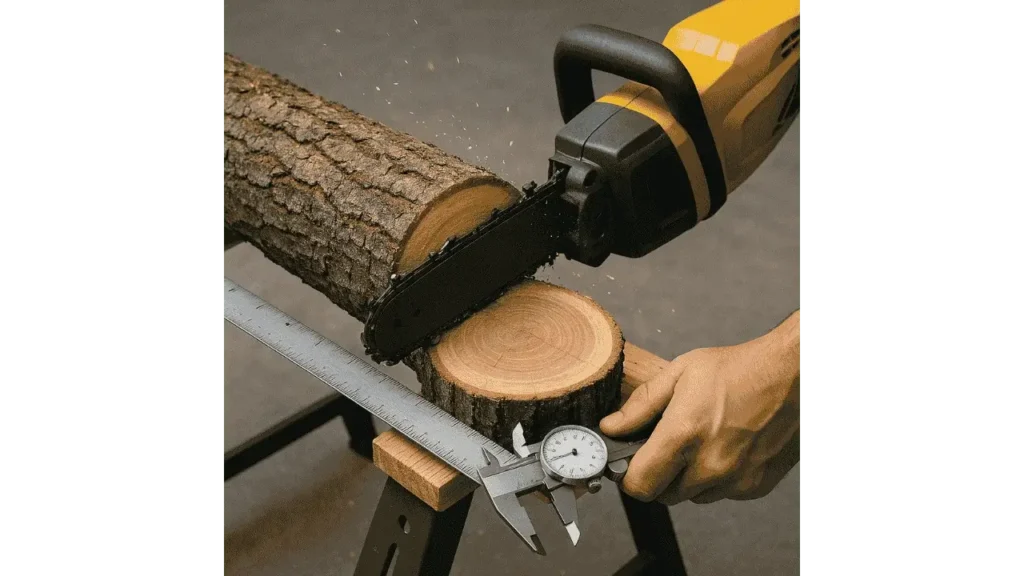Choosing the right pole saw depends heavily on knowing how thick a branch it can realistically cut. This detail matters more than many expect; it impacts pruning efficiency, tool durability, and most importantly, user safety. Selecting a saw beyond your actual needs could mean extra weight, while underestimating cutting capacity could leave you stuck mid-task. As arborist Tom Kretchmer explains,
“The right blade size saves energy, minimizes risk, and ensures the cleanest cut possible.”

Key Factors Affecting Cutting Capacity
Bar Length Rule of Thumb
The general rule is straightforward: a pole saw can safely cut a branch about 2 inches smaller than its bar length. For example, a 10-inch bar is typically suited for cutting up to 8-inch branches, while a 12-inch bar comfortably handles 10-inch ones. These guidelines are helpful, but keep in mind that actual results depend on wood type, saw sharpness, and tool stability.
Power Source & Motor Strength
The power source significantly affects cutting ability. Electric and battery-powered pole saws with stronger motors can handle denser woods more efficiently. A cordless 40V model can often cut through 8 to 10-inch limbs, whereas a basic 20V version might only manage 6-inch thickness. Corded models in the 8 to 10-amp range provide consistent power and can match the output of mid-range battery units.
Wood Type & Density
Wood density is a major variable. Softwoods like pine or spruce are easier to cut, allowing a saw to work closer to its theoretical maximum. On the other hand, dense hardwoods like oak or maple can drastically reduce efficiency. As forester Angela Mills explains,
“Density is often the silent limiter in pruning jobs; it can push your equipment past its intended use.”
Typical Branch Sizes by Pole Saw Type
Manual Pole Saws
Manual models, while reliable and lightweight, lack the motorized support of powered saws. These are best suited for branches up to 2 inches thick and are ideal for homeowners tackling basic pruning without the noise or complexity of motors.
Corded or Battery Electric Models
Electric models are popular among homeowners. Those with 8 to 10-inch bars can easily manage 6 to 8-inch branches, depending on wood type and sharpness. Higher-end units, especially those using 60V battery systems, may be capable of handling branches up to 10 inches in diameter with proper technique.
Gas‑Powered & Heavy‑Duty Saw Heads
For tougher jobs involving branches 8 inches or more, gas-powered pole saws are the go-to. These saws are built for demanding tasks and can often handle up to 12-inch branches. Professional landscapers and arborists frequently use them for tree removal, storm cleanup, and large-scale maintenance.
Practical Limitations & User Experience
Accuracy vs. Theoretical Capacity
Although a 12-inch bar can, in theory, cut a 10-inch branch, real-world conditions often limit this capability. Factors like awkward angles, fatigue, and branch height make overhead cutting difficult. Most users find that working with 6 to 8-inch limbs allows for better control and cleaner results, especially when cutting above shoulder height.
Safety & Fatigue Considerations
With greater cutting capacity comes increased weight and vibration. Larger saws are harder to manage and often lead to user fatigue, particularly over extended periods. It’s crucial to ensure that your physical endurance matches the tool’s demands. This keeps the work efficient and significantly reduces the risk of accidents.
Choosing the Right Size Based on Your Needs
For gardeners and light pruning tasks, an 8-inch bar is usually sufficient and handles branches under 6 inches well. If you’re performing routine trimming, stepping up to a 10-inch bar gives added versatility for cutting 6 to 8-inch limbs. For homeowners managing large trees or heavy pruning, a 12-inch bar or gas-powered model provides the strength and range to tackle 10 to 12-inch branches with confidence.
Final Takeaways
So, how thick of a branch can a pole saw cut? A dependable rule is: bar length minus 2 inches gives you the safe maximum branch diameter. Most electric pole saws handle 6 to 10-inch cuts effectively, while gas-powered models can tackle up to 12 inches or more. By considering the power source, bar size, and the type of wood, you’ll choose a pole saw that matches both your pruning needs and physical comfort, delivering efficient, clean, and safe results.
- How to Cut a Straight Line with a Jigsaw? - October 31, 2025
- How to Cut a Circle with a Jigsaw? - October 31, 2025
- Can You Cut Acrylic with a Jigsaw? - October 31, 2025
